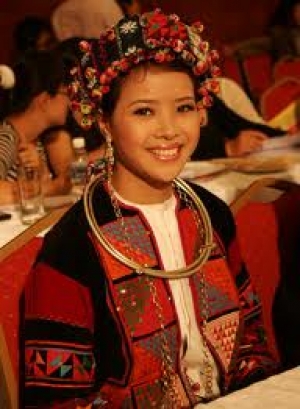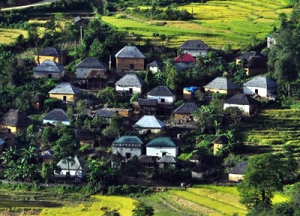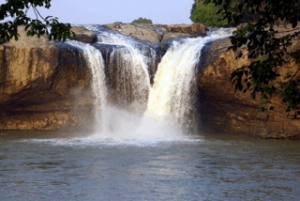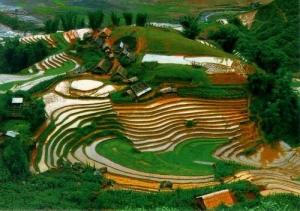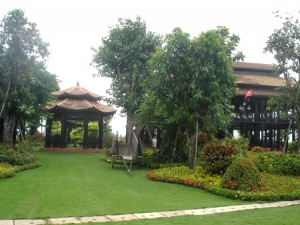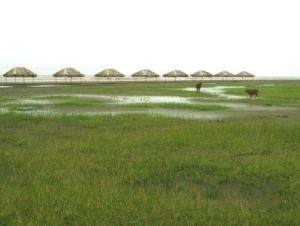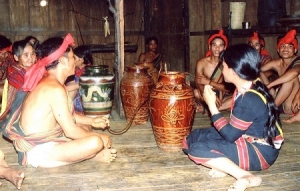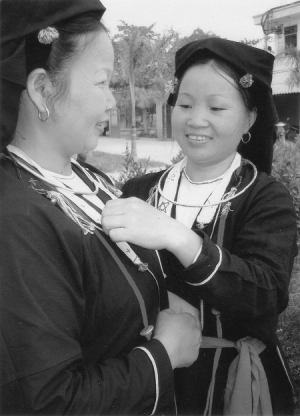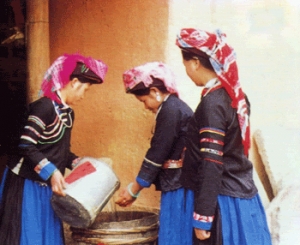
Asia Pacific Travel Team
The Gie Trieng ethnic group - One of ones keeping cultural values of Western Highland
Name of ethnic group: Name of ethnic group: Gie Trieng (Dgich, Tareh, Giang Ray, Pin, Trieng, Treng Ta Lieng, Ve, La Ve, and Bnoong)
Population: 30,243 people (Year 1999)
Locality: Kon Tum Province and the mountainous areas of Quang Ninh Province.
Customs and habits: The Gie Trieng lives in long houses built on stilts. Houses in the village are arranged in a circle around the Rong (communal house). Young woman decide when they will marry according to their own initiative. The Gie Trieng believes that all beings have a "soul" and a "spirit". Therefore ritual ceremonies and the watching of good and bad omens have prevailed. The sacrifice of buffaloes is a common ritual ceremony.
Culture: The Gie Trieng language belongs to the Mon-Khmer Group.
Costumes: Men usually wear loincloths. Women wear skirts long enough to cover their chests and some have adapted to wearing a bra sewn into their skirts.
Economy: The Gie Trieng lives mainly on the cultivation of the land, hunting, fishing, and gathering.
The Ha Nhi ethnic group - Ones has the most specific house structure
Name of ethnic group: Ha Nhi (U Ni and Xa U Ni)
Population: 17,535 people (Year 1999)
Locality: Lai Chau and Lao Cai provinces.
Also called U Ni and Xa U Ni, the Ha Nhi have about 12,500 inhabitants settling in the provinces of Lai Chau arc Lao Cai. Ha Nhi language belongs to the Tibet-Burman Group. The Ha Nhi mainly worship their ancestors. They live on rice cultivation of burnt-over land or terraced fields. They are one of the groups who have a traditional experience in reclaiming terraced fields on mountain slopes, digging canals and building small dams. They use ploughs and harrows pulled by oxens and buffaloes to work the fields. The gardens are often close to their houses.
Animal husbandry is developed as well as the weaving of cloth, wattling of basketry articles. Most of the Ha Nhi can produce clothes for themselves. Women dress varies depending on the regions. The women of Lai Chau have a decorated dress in raw colours, different from the dress of Lao Cai women which is in indigo colour only.
The Ha Nhi have adopted a sedentary lifestyle. Each hamlet contains 60 house holds. The Ha Nhi consists of many family lineages. Each lineage comprises many branches. Every year, at Tet (New Year's Day), the people of the same lineage gets together to listen to elderly men speaking about their ancestors. Some lineages recall far back their 40 generation ancestors. The children often take the name of the father or name of animal corresponding to their birthdays as their middle names. The young men and women are free to choose their partners. Each marriage goes through two stages. In the first stage, the young man and women become husband and wife. The bride comes to life with her husband's family and takes the family name of the husband according to custom of the Ha Nhi in Lai Chau province. Also in Lai Chau, matriarchy is still observed. The second stage is organized when the couple gets rich or has a child.
Funeral customs vary according to regions, but common practices have prevailed such as when a person dies, the partition making off the bedroom of the deceased is dismantled, as well as the altar to the ancestors. The dead body is placed on a bed in the kitchen and good hours and days must be chosen for burial. To determine the place of burial, an egg is tossed in the air and the grave dug where the egg hit the ground and breaks. There is no cemetery of the whole village. Around the grave, stones are piled up without building a funeral house or a protective fence. Earth grown with grass is refrained from filling up the grave.
The Ha Nhi possess many ancient tales arc stories in long verses. The young men and women play their own dances according to rhythms and accompanied by musical instruments. The young couples used to expose their love by playing leaf panpipe, lip organ and vertical flute. The young girls like to play am ba, met du, tuy huy or nat xi (various kinds of traditional flutes) when night falls. The young boys like to play la khu, a string zither. Besides, the festivals, drums, cymbals and castanets are per- formed. The Ha Nhi also have many songs such as lullabies, duet songs, wedding songs, mourning songs and songs reserved for new houses, receiving guests and welcoming Tet holidays. Particularly, a wedding song of the Ha Nhi in Muong Te district of Lai Chau province is composed by 400 verses.
Dak Nong's weather is cool year-round
The climate is relatively temperate regions, the annual temperature is 24 ° C, the hottest and coldest average difference of only 5 º C. Dak Nong Province, Vietnam, is located in the southwest of Central region with the average height of 500m above sea level. Topographically, it is relatively flat, a immense plateau with pastures stretching to the east. Lower terrain to the west, and the south is the domain of many low-lying lakes.
The climate is relatively temperate regions, with the annual temperature is 24°C, the hottest and coldest average difference of only 5ºC.
Dak Nong is suitable for visitors who love the majestic waterfall landscape, camp-fire night, the sound of gongs and the taste of the wine. Serepok River created many beautiful waterfalls, as benevolent as violent; Gia Long waterfall as a woman sleeping in wild and romantic and Dray Nur waterfall as a huge wall. Moreover, there are also many other majestic waterfalls, including Dieu Thanh waterfall, Ba Tang and Dray Sap waterfall known as Smoky waterfall.
When should you visit Lai Chau?
The ideal time to visit Lai Chau is from September to April. Lai Chau lies on high mountainous region in the North West of Vietnam, northern of Da River. There are sloping mountains, hill, valley, plateau, spring alternately. Falls and waterfalls with high flow are potential of hydroelectricity in Lai Chau.
Some attractions in Lai Chau include Tam Duong Townlet with Montagnards, Sin Ho Village with colorful Sunday Market, and other tourist sites such as: Tien Son Cave and Muong Lai Spring. The road from Lai Chau to Sapa is one of the most beautiful drives in Vietnam but it is very lumpy. Also, it can suffer severe damage during the rainy season.
Lai Chau has the typical tropical climate with two seasons: dry and rainy season. Rainy season lasts from May to September with much rain, high temperature and humidity. If you travel to Lai Chau in June, July, August of lunar calendar, be prepared that you trip might be interrupt due to hard rain. It is because 80% the rainfall of the year is allocated within these months. The average temperature in rainy season ranges from 25 – 35oC. Dry and cold season begins from November to March of the following year. This season features with cold weather and low humidity. The temperature falls low during these months with the lowest temperature of 4-5oC and thick mist, dry and cold wind, and frost. Between April and October is the transition period from rainy season to dry season. During these months, there is great difference between temperature between day and at night. Maybe, temperature in the afternoon reaches 38oC and falls down to 18-20oC.
Long An's climate - average temperature is 27.4ºC
Located on the Mekong Delta, Long An is more than 50km from Ho Chi Minh city, the largest city of Viet Nam. Long An is divided into smaller areas by a complex network of rives and canals. Silt from Vam Co Dong and Vam Co Tay rives has raised the level of the field of Long An. and it maked a good condition for agriculture. Topographically, it is quite flat except some hills and mounds on the north. The western area belongs to the Plain of Reeds.
Long An has tropical monsoon climate. The rain season lasts between May and October and the dry season lasts from November to April next year. Annual average temperature is 27.4ºC. Annual average rainfall is 1,620mm.
Travelers are attracted to Long An by value of Oc Eo culture that develops on the Mekong Delta from 1st BC to 6th century BC. Besides, Long An preserves valuable sites including House with Hundred Columns, Ton Thanh Pagoda, Rach Coc Fort. In Dong Thap Muoi Eco-tourist Site, visitors can discover many special flora and fauna and try typical dishes of the South.
The average temperature of Tra Vinh is 26.6°C
Tra Vinh Province belongs to Mekong River Delta in the South of Vietnam, and having a long coastline of 65km with East Sea on the East. Tra Vinh province is divided into coastal plain, alluvial deposits, mounds and sand caves, and complex network of rivers and canals. Due to ly in tropical monsoon region, the weather in Tra Vinh is hot all year around Tra Vinh with abundant light condition and high and stable temperature. However, because of the climate features of coastal region, Tra Vinh is also suffered from difficulties such as strong wind, high level of evaporation and low rainfall.
Tra Vinh’s climate isn’t perceptively divided into 4 main seasons; but dry season and rainy season. Rainy season lasts from May to November of a year and dry season lasts from December to April of the next year. The distribution of rainfall is unequal and descending from north to south of Tra Vinh. The humidity varies from 80-85% which depends on whether in rainy season or dry season.
Should you have comprehension of climate and weather condition before taking a visit to Tra Vinh Province. You will find out the best time of a year which will be suitable for your vacation in a province of Mekong Delta.
Xo Dang Ethnic Group
The Sedang (Xo Dang) live in Kon Tum province, Tra My and Phuoc Son district of Quang Nam province, and Son Tay district of Quang Ngai province. The largest population of Sedang is around the Ngoc Linh Mountain. They live in stilt houses.
Proper name: Xo Dang (Hdang, Xdang, Hdra), Mnam, Ca Dong, Ha Lang (Xlang), Tay Tri (Tay Tre), Chau.
Other names: Hdang, Kmrang, Con lan, Brila, Sedang
Population: 96,766 people
Local groups: Xo Teng, To Dra, Mnam, Ca Dong, Ha Lang, Tay Tri, Chau.
Language: Sedang language belongs to the Mon-Khmer language family (Austroasitatic language family). Their language is very similar to Hre, Bahnar and Gie-Trieng languages. There are some different vocabularies among groups. The Sedang use the Latin alphabet for their writing system.
History: The Sedang are long time inhabitants around the area of Truong Son – Tay Nguyen central highlands regions in Quang Nam, Quang Ngai provinces.
Economic activities: A faction of the Sedang practice wet-rice cultivation. Their cultivation technique is not all that well-developed. They work the fields by herding water buffaloes into it, so that the buffalo’s hooves work the soil. They use hoes, which are made from wood (steel ones are used now). The majority of Sedang work on terraced fields, using the same techniques and tools as other Ethnic groups in the region. They use the axe and machete to cut down trees, and then burn them. To plant seedlings, a hole in the ground is made using a pointed digging stick with an iron tip. To weed, the Sedang use little hoes made from tree branches. At harvest, the Sedang pluck the ears of rice off with their hands. In addition to rice, the Sedang also plant millet, corn, cassava, pumpkin, tobacco, melon, pineapple, banana, sugar cane, etc. traditional domestic animals are water buffaloes, goats, pigs, dogs, and chickens. Fruit picking, hunting and fishing are also play an important role in their economy. Among the Sedang, weaving appears in many regions. Hammerings is highly developed within the To Dra group. They know how to transform one into iron for hammering. In some places, the Sedang are gold-washers. Bamboo is also developed to produce household furniture. Although barrier trade was commonly practiced, nowadays, the Sedang use money for most of their transactions.
Diet: The Sedang eat rice and sticky rice with chili salt and food hunted or gathered in the forest. Only when worshipping do the Sedang eat meat and poultry. Popular foods included soup cooked with vegetables or bamboo shoot mixed with fish and meat, snails, and grilled foods. The Sedang drink fresh water (many boiled water nowadays), and wine. There is a special wine made from millet which is much better then from rice or cassava.
In some places, the Sedang have the custom of eating betel nut. Men and women both smoke tobacco into powder and chew it instead of smoking it.
Clothing: Men wear loin cloths. Women wear skirts and blouses. When it is cold, they wrap themselves in blankets. In the ancient past, many of the Sedang wore clothes made from bark. Today, Sedang men wear clothes in a style similar to the Viet, and women wear shirts and skirts made from ready made materials. Sedang traditional textiles are either white or lack, with only a little black, white or red decoration.
Lifestyle: The Sedang live in Kon Tum province, Tra My and Phuoc Son district of Quang Nam province, and Son Tay district of Quang Ngai province. The largest population of Sedang is around the Ngoc Linh Mountain. They live in stilt houses. In the past, the Sedang households used to live together in a longhouse, but now there is a greater tendency to split into small family units. The location of houses differs among groups; in some groups, private houses are clustered around a communal house. Building techniques rely on the use of columns, and fiber lashings hold the various architectural elements together. There are two rows of columns in each house.
Transportation: The Sedang use carrying baskets those vary in form and technique. Some are thickly woven, others are of thin weave. Some baskets have lids, others do not; some are decorated. Men have their own three-compartment baskets (some in the form of a snail, others resembling bat wings) which they carry on the shoulder to transport just about everything.
Social organization: Each village is self-ruled, with the eldest man as its leader. The village’s territory is communal, and every individual has the right to own land. Even though there has long been a distinction between rich and poor, there has not been a practice for the former exploiting the later. In the past, there was servitude, but servants were not badly treated. A sense of community is highly regarded.
Marriage: This custom is a bit different in each region. However, it is a popular Sedang custom that after the wedding, the couple rotates the residence every couple of years so that they can live with both set of parents. The couple will live permanently in one place only after both sets of parents are deceased. In the wedding, the groom and bride chicken thighs, wine, and food which symbolize the connection between the two. Marriage is not commercialized.
Funerals: Everyone in the village comes to offer their condolences, and to help with the funeral. The coffin is made from unpolished wood. People are normally buried in the village cemetery. Sedang funeral customs aren’t completely analogous to those of other Ethnic groups in the region: the ceremony to abandon the tomb, characteristic of the Bahnar and Giarai, does not exist everywhere. The custom of chia cua (conservation of property like the Clothing, personal objects, farming tools and household utensils, etc.) for the deceased is widespread.
Beliefs: The Sedang believe in supernatural powers. Gods and ghosts are called Kiak (Kia), or “Ong”, “ba”, some places call them Yang. Important gods are Lighting God, the Sun God, Mountain God, Rice God, and Water God. The water God is in the image of a serpent, or a big eel, or a pig with a white nose. The Sedang Rice God is in the image of an ugly, old but kind woman, who later becomes frog. There are many rituals offered to supernatural powers to pray for good harvest, for peace, and to send away bad lack.
Festivals: The most important Festivals are the rituals to the Water God on the yearly occasion of repairing water pipes. There are other rituals held at the beginning of each crop season, while seeding, in the middle of the crop season, when harvesting, when there is someone sick, when building a new house, when children are grown up, etc. There are many communal religious Festivals such as the offering sacrifices to the Water God and the buffalo sacrifice held by a family or a village. Traditional holidays happen at different times in different villages and families, but they usually occur in January and lasts for 3 to 4 days.
Calendar: There are 10 months in the Sedang calendar connected to the agricultural cycle. There is a rest after the harvest to wait for a new crop. Each month has 30 days. Each day is divided into specific moments and called different names. There are good days and bad days. For examples, the last day of a month is good for planting corn; if the Sedang chop down bamboo at this time, it is said that they can use it for a long time and it won’t spoilt.
Artistic activities: The Sedang have many kinds of musical instruments (two-stringed Chinese violin, flute, pipe, drum, gong, horn, etc.). Some are for daily use; some are for festival use only. Instruments and melodies are different among groups. Popular types of music are: call and response or alternating verse of young couples, songs of grown-ups, lullabies. The Sedang perform dances in some Festivals; there are specific dances foe men, women, and both together. Sedang folktales are rich and distinctive.
San Diu Ethnic Group
The Sandiu mainly live in the midlands in the northern region, from the left-bank of the Red River to the east. Their villages are similar to Viet villages, often surrounded by bamboo rows and fences between houses. They live in cottages with earthen or plank walls.
Proper name: San Deo Nhin (or Son Dao Nhan)
Other names: Trai, Trai Dat, Man quan coc (which means “man-in-shorts”), Man vay xe (“man in split cloth”).
Population: 93,530 people
History: The Sandiu migrated to Vietnam about 300 years ago.
Production activities:The Sandiu cultivate more on dry fields and less on submerged fields. Apart from their common crops such as rice, maize and manioc, they also grow many kinds of root plants. The Sandiu have long used manure to fertilize the soil. Thanks to an extra blade, their ploughshares are much shaper and, thus, more suitable for cultivating the tough and gravelly land of the Sandiu region.
Diet: The Sandiu mainly eat ordinary rice, often mixed with sweet potatoes and manioc. After meals, they like to have watery porridge of a type also enjoyed by the Nung.
Clothing: The traditional costume of the Sandiu women includes a black shawl and a long blouse with single or double layers. If a double-layered blouse is worn, there is a white shorter blouse inside the indigo-colored outer blouse, a red brassiere and a white, pink or blue belt. Their dress is made from two separate laps connected in one hem; its length stretches to the knees. It is dyed indigo while the waist-band is white in color. Sandiu jewelry for women is comprised of a necklace, bracelet, earrings and the silvery sa tich. Sandiu men’s costume is much like the Viet’s style: traditionally, they wind their hair on the top of the head, and wear turbans, black ao dai (traditional long dress), and white pantaloons.
Lifestyle: The Sandiu mainly live in the midlands in the northern region, from the left-bank of the Red River to the east. Their villages are similar to Viet villages, often surrounded by bamboo rows and fences between houses. They live in cottages with earthen or plank walls.
Transportation: Apart from using their shoulders to carry things, they also use the no-wheel carts as a means of transporting goods. This cart is made of bamboo and wood, drawn on sled ties by buffaloes and used for transporting everything from rice to fire-wood, to manure. Because the cart does not have wheels, it operates well on a variety of terrains.
Social organization: Before the August Renovation in 1945, land and fields had been privatized and social classes was clearly defined. Landlords and rich peasants occupied most of the land and fields and exploited peasants and farmers though renting land, hiring labor, and charging high interest loans. In addition to the administrative government, each village has a chief elected by the people to govern public affairs.
Marriage: Boys and girls are given the freedom to love, but their marriage also depends on their “destiny” and on their parents’ final decisions.
There are many rites in a Sandiu wedding ceremony. Most notably, there is often a ceremony called le khai hoa tuu (opening ceremony of the flower liquor) at the home or the girl’s family. People prepare a bottle of wine and a dish on which two pieces of paper flowers are put – the white flower is put under the red one which rests on top. Two boiled eggs are put on the dish, threaded with red string and tied with two coins on either ends. After worshiping, the shells of the boiled eggs are taken off and their yolk is mixed with the wine for a drink toasting the couple.
Funerals: When the dead body is lowered into the grave, his or her children standing at the foot of the coffin should crawl around the grave. The boys should do it from the left, and the girls do it in the opposite direction. They should be pushing the soil into the grave while crawling. When they stand up, each one will take a handful of soil and run fast towards their homes and put he soils into the buffalo pens and pigsties with the hope that the cattle and animals will grow quickly. Then they will also run into their houses, and sit in a rice basket in belief that those whose have lots of rice sticking to their bodies will be the lucky ones. Finally, each person tears a piece from a boiled chicken to eat. The eldest will get the cockscomb and those next in line receive the head, neck, and wings.
The grave house is often flat-roofed structure covered with forest leaves. In an exhumation ceremony, the bones of the deceased are put in a small earthenware coffin or a big jar and arranged in a sitting manner. If a fortunate day has yet to be selected beforehand, the dead will be re-buried at the foot of a hill or on a field bank.
New house: When a person or a family builds a house, relatives and villagers are willing to come and help out without being asked to do so. To celebrate a new house, the house owner should invite an elder in the lineage to bring fire, a lime pot and seeds into the house.
Beliefs: Usually three incense bowls are put on the altar to worship ancestors, the shaman and the Kitchen God. If the host is not initiated, there will be only two incense bowls. An incense bowl is also put on the altar but at a lower level to worship the dead. In addition, the Sandiu also worship earth spirits at joss houses and the village’s tutelary god at shrines.
Festivals: The Sandiu also celebrate different Festivals like other groups in their regions. In particular, the winter Tet season expresses their hopes for many descendants. Couples who do not have a child long after their marriage will move to live at the parents’ house after the Tet festival. The husband, then, will send a middle man to ask his wife back and they will hold a brand new wedding ceremony.
Calendar: The Sandiu respect the lunar calendar.
Education: In the past, young people learned Chinese to become ritual specialists, but few know Chinese today.
Artistic activities: Like other groups, Sandiu couples also sing alternating songs at night, which they call soong co. Some performances last for several nights.
The Bahnar Ethnic Group - The ethnic minority of the unique folk songs, traditional musical instruments
Anyone who listens to the sound of a musical instrument, it is the T'rung agrees that they feel pleased and impressive when listening it. The sound of T'rung is said to resemble that of the running or falling water from the streams and waterfalls in the Highlands - the sound of the Bahnar highlands, the resilient Bahnar peopel - the beauty of Vietnam’s cultural patrimony.
Proper name: Bahnar
Other names: Bo Nam, Roh, Kon Kde, Ala Kong, Kpang Kong, etc.
Population: 136,859 people
Local groups: Ro Ngao, Ro Long (or Y Lang), To Lo, Go Lar, Krem.
Language: Bahnar language belongs to the Mon-Khmer language group (of the Austroasiatic language family).
History: The Bahnar are long-term inhabitants of Truong Son-Tay Nguyen central highlands. They have created a unique local culture and their own socio-culture identity, perform a charming Vietnamese Culture.
Production activities: The Bahnar live mainly on the cultivation of swidden fields and slash-and-burn agriculture. The hoe is main food used in agricultural production. Intensive land cultivation of swidden fields using the slash-and-burn method dispenses with the notion of allowing fields to go fallow after a period of time. In general, swidden fields are located near rivers and stream and have long been popular among the Bahnar. But since the beginning of the 20th century, wet rice cultivation using harrows is also practiced. Horticulture and diversified crops also appeared quite along time ago. Animal husbandry and craft production, such as basketry, cloth weaving, pottery and blacksmithing, are less developed.
Lifestyle: The Bahnar people live in vast areas from Gia Lai and Kon Tum to the west of Binh Dinh, Phu Yen and Khanh Hoa provinces. They mostly live in stilt houses, which are characterized by having the entrance door at the front of the house. The roofs are decorated with horns at either end. There is a communal house (nha rong), identified from other dwellings by its magnificent high roof. The communal house is a place where public activities are held, including education for the youth, ceremonies, trials, etc.
Transportation: The chief means of transporting things is the gui (bamboo or rattan backpacks). The gui has many sizes and types and can be woven differently, but usually follow traditional motifs.
Social organization: The village is primary social unit. Vestiges of matriarchal social structure are still in evidence in b family relations, lineages systems, and marriage. The decline of matriarchy has raised the position of men, but social relationships still tend to be closer to the mother’s family. After marriage, the Bahnar custom still prevails that the groom stays at his wife’s house. Society is differentiated among those who are rich, those who are poor, and those who are classed as servants.

Marriage: Monogamy is a basic principle of Bahnar marriage. The exchange of living places by the newly-married couples is increasingly popular. After a period of time when the husband lives at his wife’s house, and vice versa, the couple then moves to a new place to settle and becomes a new cell of the community.
Education: Education for youths takes place at the communal house, taught by the village elders. This traditional education includes job training, marital arts, combat techniques, and the values of the community.
Artistic activities: Folk songs are ample, but more popular ones are hmon and roi lyrics. Musical instruments played by the Bahnar include percussion and aero phone instruments as well as chordophones (stringed instruments). Traditional dances are popular, performed on ceremonial occasions and seasonal Festivals. The long poems and folktales of the Bahnar are unique, traditional works that are an important part of Vietnam’s cultural patrimony.
Games: Among the popular folk games are chasing (dru dra), rope seizing, stone throwing, ball kicking spinning top, and khang playing.
The Bru - Van Kieu - the Ethnic Group has the most permanent residents in the Truong Son region
Located at Truong Son-Tay Nguyen, the mountain villages of the Bru - Van Kieu are steep, crooked, squeezed as great tapesties of Truong Son jungle. For hundreds years, the people here have created a good deal of myths that have been handed on through successive generations. This land is an invitation for adventurers, who want to explore the national frontiers.
Proper name: Bru, according to some researchers.
Other names: Bru and Van Kieu
Population: 40,132 people
Local groups: Van Kieu, Tri, Khua and Ma Cong.
Language: The Bru language belongs to the Mon-Khmer language group (of the Austroasiatic language family), which is close to languages spoken by the Tay Oi and Cotu people. A new Bru writing system is now emerging, which uses Latin transcription. Some vocabulary and phrases are different between certain sub-groups.
History: The Bru are believed to be the most permanent residents in the Truong Son region.
Production activities: The Bru live mainly on swidden fields, using simple tools such as the axe, the cutlass, and the rice harvesting knife. They practice slash-and-burn agriculture, using a digging stick to make holes in the ground for sowing seeds. Weeding and rice harvesting are done by hand. Multi-crop and rotating cast crops are grown each year between March and October. Apart from paddy, the Bru also grow manioc, gourd, banana, egg-plant, pineapple, sweet potato, etc. Forests and streams are the two main sources for additional food and other benefits. Almost every family raises buffalo (later cows), pigs, chickens, and dogs. Local handicrafts are less developed. Meanwhile, the Bru engage in barter trade primarily with the Viet people as well as with Laotians.
Diet: The Bru-Van Kieu enjoy eating roasted meat. Soup usually made with a combination of vegetables, rice, and fish or frog meat. For everyday meals, ordinary rice is often eaten with the hands. On special occasions, sticky rice is cooked in a fresh bamboo tube. Unboiled water and can (pipe) wine are the most popular drinks (although nowadays distilled spirit is becoming more and more popular). Men and women smoke cigarettes and pipes made from earth or the le plant (a sort of bamboo shoot)
Clothing: According to Bru customs, the men wear loin cloths and the women wear dresses with a sleeves blouse or pullover. The Bru buy textiles from Laos. Dressing in the style of the Viet people is becoming more and more popular, with cloth wrappers still being worn. In the past, people used to make Clothing from the fibre of tree bark. People adorn themselves with chains, necklaces, and earrings. Formerly, Bru men and women wore their hair wrapped in a bun or chignon on the top of their heads. For an unmarried girl, the chignon of a married woman is generally at the center top of the head.
Lifestyle: The Bru-Van Kieu live in the Truong Son-Tay Nguyen region in the west of Quang Tri, Thua Thien_Hue and Quang Binh. Each village is a residential community. Each family owns a house, built on stilts, with the heart and kitchen placed on the ground level. The Bru-Van Kieu avoid sleeping in a direction that is across the width of the house, in the sub-groups of Tri, Khua and Ma Coong, the house is divided into smaller bedrooms for the aged parents.
 Transportation: The Bru uses many kinds of woven back-baskets, with the straps being tied around the shoulders of the carrier. The multi-purpose back-basket and the carrier inseparable like the human body and its shadow.
Transportation: The Bru uses many kinds of woven back-baskets, with the straps being tied around the shoulders of the carrier. The multi-purpose back-basket and the carrier inseparable like the human body and its shadow.
Social organization: Villagers, who are of different family lineages, live in harmony, with land plots (even fallow land) being divided for each family. The eldest person in the village plays an important role in the village’s life. The gap between the rich and the poor is increasing, but there is little difference in the standard of living at the village level. Valuables are counted in gongs, pots, cooking pots and buffalo, etc. Human exploitation or servitude is uncommon.
Marriage: Traditionally, the bride is brought to her husband and the wedding is organized by the bridegroom’s family. Customary wedding gifts are the sword and a bronze cooking pot. After the wedding, and once the couple has sufficient economic resources, they hold a “second wedding” called Khoi ceremony, where the wife is officially regarded as a member of her husband’s family. According to the customs, cross-marriages within a family lineage is encouraged, such as between the aunt’s son and the uncle’s daughter, between the widow and her dead husband’s brother, and vice versa. In addition, if a woman in lineage A is betrothed to a man in linage B, lineage B is no longer able to offer women in marriage to men of lineage A.
Birth: Pregnant women must abstain from eating the meat of hunted animals and from walking over a tree log that lies across the road. Bru women usually deliver at home, helped by a mid-wife. The baby is named after three months; the name must nor coincide with the names of the dead members of the family, but only bear a similarity in sound or syllable.
 Funerals: According to Bru customs, the dead person is placed across the house floor, with the feet pointing to the windows. In the sub-groups of Khua and Marriage Coong, the deceased is laid along the floor, with the feet pointing to the main door. The funeral is often held two or three days later, and the deceased is buried at the village’s common graveyard. The coffin, made of a kind of soft wood, has a cover. In the past, the deceased used to be wrapped in bark or a bamboo-woven sheet. The burial place is determined by dropping an egg onto the place, which is acceptable if the egg breaks. Before the burial, food is put into the deceased’s mouth, and the deceased is buried together with plenty pf personal belongings, food, and the seeds of cane, corn, and Indian taro, etc.
Funerals: According to Bru customs, the dead person is placed across the house floor, with the feet pointing to the windows. In the sub-groups of Khua and Marriage Coong, the deceased is laid along the floor, with the feet pointing to the main door. The funeral is often held two or three days later, and the deceased is buried at the village’s common graveyard. The coffin, made of a kind of soft wood, has a cover. In the past, the deceased used to be wrapped in bark or a bamboo-woven sheet. The burial place is determined by dropping an egg onto the place, which is acceptable if the egg breaks. Before the burial, food is put into the deceased’s mouth, and the deceased is buried together with plenty pf personal belongings, food, and the seeds of cane, corn, and Indian taro, etc.
Beliefs: The Bru attach great importance to ancestor worship. They believe that the embodiments of their dead love one’s souls exist in such objects as a fragment of a pot or a bowl. Etc. in some places, people believe in the god of their own fortunes: each member of the family has a bowl to his or her own fate, placed on a common altar. People also believe in various Yang (God) such as god of paddy plants, and mountain, the land and earth, the river, the tree and the kitchen, etc. the genie or protective spirit of the wife’s family is also worshipped by the husband-in-law.
Festivals: The Bru perform different rituals in an attempt to harvest bumper crops. These rites are connected to specific stage of agricultural production, such as clearing the field, sowing the seeds, and harvest. Sowing seeds, in particular, is organized as major Festivals of the village. The life of a Bru is accompanied by serials of rituals: birth, sickness, marriage, death…The most important event is the buffalo sacrificing ceremony. Tet is celebrated in villages at different times, usually after the rice has been harvested and threshed.
Calendar: their calendar is made based on the position of them moon. The Bru identify days of good luck (the 4th, 7th, 9th of the lunar month) and bad luck (30th and 1st of the lunar month). Each year, the agricultural calendar adopted by the Bru comprises 10 months, followed by holidays, before entering into the next crop cycle.
Artistic activities: The Bru preserve a large number of old tales about the origin of local family lineages, peoples, and orphans, etc. Folk singing is popular, such as Oat (alternative chants between men and women); Prdoak, songs of greetings; Xuot, songs of public occasions; Roai tol, Roai trong, sad sung stories; and Adang kon, the lullaby. When there are burials and buffalo sacrifice Festivals, songs are often accompanied by dances. The most popular musical instruments are: gongs, drums, string instruments (achung, plua, talu), and wind instruments (aman, taral, kho lui and pi), etc.


